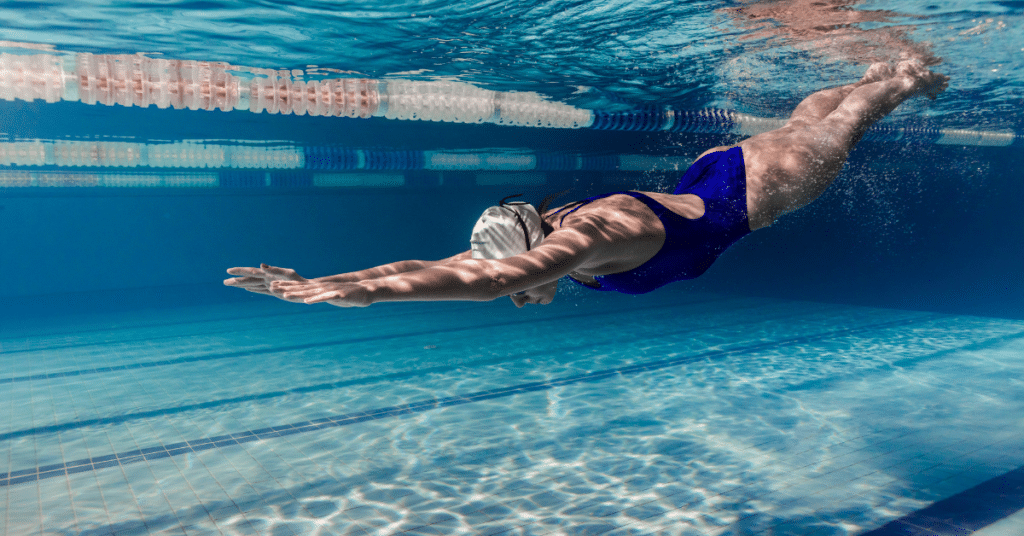Best Swimming Strokes for Knee Pain
You may have read this previous article about the best forms of exercise for people with knee osteoarthritis. The forms we covered are stretching, walking, cycling, and one of the very best exercises for knee pain, swimming.
Today we are going to take a deeper look at the benefits of swimming.
Swimming is a low-impact cardiovascular form of exercise that has been shown to reduce joint pain and stiffness associated with osteoarthritis. Even more, it can also improve muscle strength and functional capacity in middle-aged and older adults with osteoarthritis-related knee issues.
We know swimming has been proven to be a beneficial form of exercise for people with osteoarthritis, however, when it comes to the type of stroke one does, some are very beneficial while others can be problematic and do more harm than good.
So let’s dive a little deeper and take a look at the main swimming strokes and their impact on the knees.
Front Crawl:
This stroke is not only the fastest most efficient swimming stroke, but it also happens to be one of the best for healing osteoarthritis pain. In order to get the full benefits of this stroke, it is important to make sure you are using the correct technique. There are plenty of online videos and tutorials to help you with this. It can also be beneficial to spend some time with a more experienced swimmer, coach, or teacher. They can help make any proper adjustments to make sure you are getting the most out of the stroke.
Backstroke:
This stroke is also one of the faster strokes and is great for stretching the shoulders and for exercising the knees. Just like the front crawl, swimming the backstrokes forces the leg to travel in a straight line, kicking from the hip. The lack of sideways movement means that both of these strokes are ideal for people with knee osteoarthritis.
Now for the strokes to avoid:
Butterfly:
The first one is the easiest to avoid because it is by far the most difficult to do. And that is the Butterfly.
Not only is the butterfly the most difficult stroke, but when it comes to people with osteoarthritis, this stroke can be downright harmful.
The problem is the type of kick that is part of the butterfly stroke. Oftentimes referred to as the “dolphin kick”, it requires that the feet and knees remain together, kicking up and down in unison. This motion, which helps propel the body out of the water while the arms rotate forward more often than not, can cause an increase in knee pain.
Breastroke:
The other stroke to avoid if you have knee issues is unfortunately one that most people tend to prefer the most, and that is breaststroke.
Swimming breaststroke puts excessive side-to-side and rotational forces on the joints and may be difficult to do if the joint is unstable. Not only is this kick difficult to do with knee pain, but it can be harmful and make knee issues worse.
The preferred direction of force is to keep the leg straight and bend the knee. This is why a kick, as done in front crawl and backstroke, is preferable for those with knee issues.
This isn’t to say that you absolutely can not do the breaststroke, but it is to say to proceed with caution, and when doing longer swimming sets, be sure to do the other strokes as well.
When done regularly and correctly, you should notice that your joints are likely to be much less stiff after a swim than when you entered the pool. This is especially true if you swim in warm water. When warm water and physical activity are combined, it can help increase blood flow throughout the body- which in turn, can help carry more nutrients and oxygen to all of the joints and lubricate them to move more fluidly.
So there you have it, swimming is a great way to help relieve the symptoms of osteoarthritis in the knees- however, when it comes to swimming with osteoarthritis, it’s important to remember that not all strokes are created equal. Sticking with the front crawl and backstroke is the best bet, and getting a little help to ensure proper technique can go a long way both in and out of the pool.
For more helpful tips on how to use swimming to reduce knee pain, you can check out this website.


